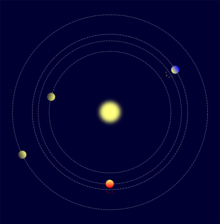| Observation data Epoch J2000.0 Equinox J2000.0 | |
|---|---|
| Constellation | Cygnus |
| Right ascension | 19h 53m 16.4202s[1] |
| Declination | +47° 16′ 46.308″[1] |
| Characteristics | |
| Apparent magnitude (g) | 15.903[2] |
| Apparent magnitude (r) | 15.301[2] |
| Apparent magnitude (i) | 15.105[2] |
| Apparent magnitude (z) | 14.963[2] |
| Apparent magnitude (D51) | 15.667[2] |
| Apparent magnitude (J) | 14.095[2] |
| Apparent magnitude (H) | 13.727[2] |
| Apparent magnitude (K) | 13.632[2] |
| J−K color index | 0.463[2] |
| Characteristics | |
| Spectral type | G[3] |
| Astrometry | |
| Proper motion (μ) | RA: −4.227(25) mas/yr[1] Dec.: −11.094(24) mas/yr[1] |
| Parallax (π) | 0.5005 ± 0.0215 mas[1] |
| Distance | 6,500 ± 300 ly (2,000 ± 90 pc) |
| Details | |
| Radius | 1.095[2] R☉ |
| Surface gravity (log g) | 4.386[2] cgs |
| Temperature | 5,599[2] K |
| Metallicity | -0.211[2] |
| Other designations | |
| Database references | |
| SIMBAD | data |
| KIC | data |


Kepler-223 (KOI-730, KIC 10227020) is a G5V star with an extrasolar planetary system discovered by the Kepler mission. Studies indicate that the Kepler-223 star system consists of 4 planets orbiting the star.[5][3]
- ^ a b c d Cite error: The named reference
Gaia DR3was invoked but never defined (see the help page). - ^ a b c d e f g h i j k l m "KIC10 Search". Multimission Archive at STScI. 8 October 2009. Retrieved 5 March 2011.
- ^ a b Cite error: The named reference
Mills2016was invoked but never defined (see the help page). - ^ Cite error: The named reference
Simbadwas invoked but never defined (see the help page). - ^ Borucki, William J.; Koch, David G.; Basri, Gibor; Batalha, Natalie; Brown, Timothy M.; Bryson, Stephen T.; Caldwell, Douglas; Christensen-Dalsgaard, Jørgen; Cochran, William D.; Devore, Edna; Dunham, Edward W.; Gautier, Thomas N.; Geary, John C.; Gilliland, Ronald; Gould, Alan; Howell, Steve B.; Jenkins, Jon M.; Latham, David W.; Lissauer, Jack J.; Marcy, Geoffrey W.; Rowe, Jason; Sasselov, Dimitar; Boss, Alan; Charbonneau, David; Ciardi, David; Doyle, Laurance; Dupree, Andrea K.; Ford, Eric B.; Fortney, Jonathan; et al. (2011). "Characteristics of planetary candidates observed by Kepler, II: Analysis of the first four months of data". The Astrophysical Journal. 736 (1): 19. arXiv:1102.0541. Bibcode:2011ApJ...736...19B. doi:10.1088/0004-637X/736/1/19. S2CID 15233153.